Some time ago our friend, collector Carla Bosch, decided to undertake an expedition to her attic and to inspect some boxes. Carla: "In one of those boxes I found 16 cards I forgot all about. I cannot remember when and where I bought them. They are rather large black and white cards, about 18 x 12 cm. On the back are the names of famous actresses in a language I know must be East European: Romy Schneiderova, Sophia Lorenova, Marilyn Monroeova, Brigitte Bardotova. Male actors, on the other hand, keep their name: Gérard Philipe, Tony Curtis, Jack Lemmon, Clark Gable. When I put some of the words through ‘Google Translate’, I found they were Czech cards. The Germans have a nice word for something you find, often unexpectedly, in your attic: Dachbodenfund. This is my Dachbodenfund.
Carla: "There are four cards of the movie Kdyby tisic klarinetu. “If a Thousand Clarinets” (English title) is a Czechoslovak movie released in 1965. It is a fantasy musical film about a mysterious statue of the composer Johann Sebastian Bach that changes guns into musical instruments. The news spreads and a television station decides to make a documentary film about the subject. My guess is that it must be something like how music can change people. And, more particular, how soldiers change when they are not holding guns, but music instruments instead... But that is just a wild guess.
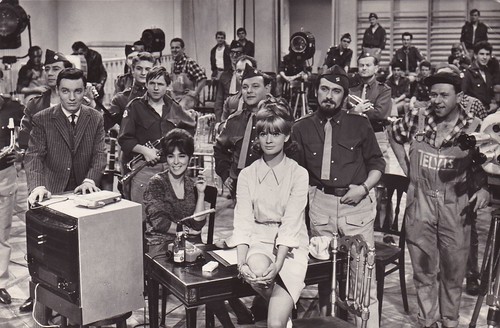
Czech postcard by Pressfoto, Praha (Prague). Photo: publicity still for Kdyby tisic klarinetu/If a Thousand Clarinets (Ján Rohác, Vladimír Svitácek, 1965) with at left Karel Gott and Jana Brejchova in white. Collection: Carla Bosch.
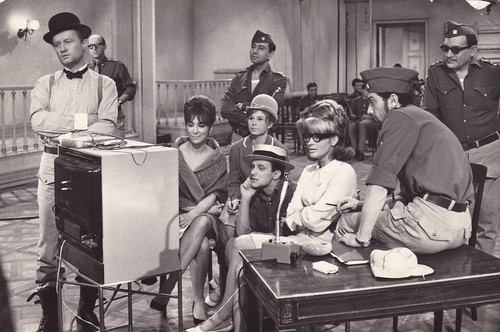
Czech postcard by Pressfoto, Praha (Prague). Photo: publicity still for Kdyby tisic klarinetu/If a Thousand Clarinets (Ján Rohác, Vladimír Svitácek, 1965). Collection: Carla Bosch.
I suspect that on these two cards are the film crew making the documentary. With Jana Brejchova, Waldemar Matuska, Hana Hegerova, Eva Pilarova, Karel Gott, Jiri Suchy, and Jiri Slitr. They are all watching a television. In the public are soldiers who are holding music instruments.

Czech postcard by Pressfoto, Praha (Prague). Photo: publicity still for Kdyby tisic klarinetu/If a Thousand Clarinets (Ján Rohác, Vladimír Svitácek, 1965) with Pavlina Filipovska. Collection: Carla Bosch.
Czech actress Pavlina Filipovska plays the role of landlady of a pension. In this picture she sits on a piano and four 'soldiers' are playing the saxophone.
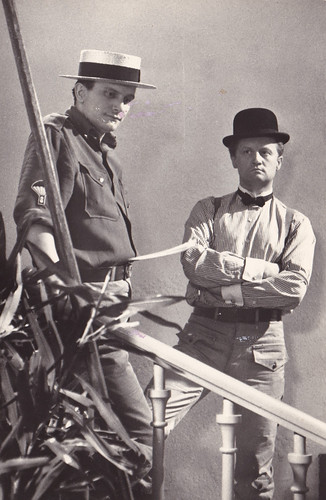
Czech postcard by Pressfoto, Praha (Prague). Photo: publicity still for Kdyby tisic klarinetu/If a Thousand Clarinets (Ján Rohác, Vladimír Svitácek, 1965) with Jiri Suchy and Jiri Slitr. Collection: Carla Bosch.
The fourth card is with Jiri Suchy and Jiri Slitr, both Czech actors. I read that Jiri Suchy was responsible for the story and Jiri Slitr composed the music. They also play a role in the movie; they are both paratroopers. In this picture they have cast off their military uniform and wear civilian clothes with cool hats.
I don’t know the Czech language. When I used Google Translate, I doubted Google’s translation skills. And as there was not much published about this movie in English, I had to make guesses. I did understand, however, that the film received some enthusiastic reviews. Although the subject, provide soldiers with music instruments and take away their guns, seems rather corny, it apparently touched a (musical?) string.
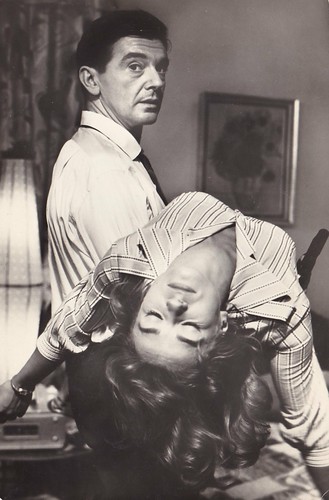
Czech postcard by Pressfoto, Praha (Prague). Photo: publicity still for Egy ember, aki nincs/Key to the Murder (Viktor Gertler, 1964). Collection: Carla Bosch.
There is one card of the movie Klic k Vrazde. In English Key to the Murder. Immediately my imagination ran wild in connection with this card: a murderer with a dead woman in his arms…. On the run and thinking where to hide the body. I tried to look up this movie on the internet, but I found there was not much to look up.
It is a Hungarian movie with Miklos Gabor and Eva Vass, who are both on the card, in the leading roles. Miklos Gabor was married to Éva Ruttkai and later to Eva Vass. I cannot find the marriage dates, because that might have provided a juicy gossip. So I think it is safe to conclude that Miklos murdered Eva and is looking around with an uncertain look on his face where to hide her. Maybe he did not kill her on purpose. Perhaps there are Czech readers or experts of Czech cinema who can comment on or clarify this mysterious picture?
I started to describe the 'difficult' postcards. It took a lot of time to find nothing. I think I must have bought these cards because of the more famous movie stars:
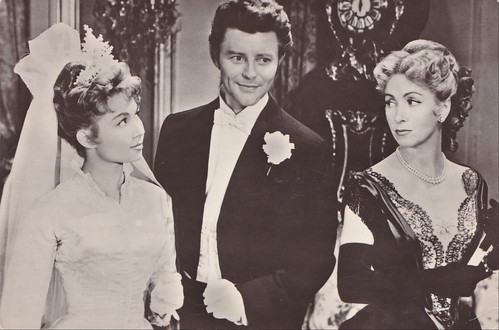
Czech postcard by Pressfoto, Praha (Prague). Photo: Dany Carrel, Gérard Philipe and Danielle Darrieux in the Émile Zola adaptation Pot Bouille/Lovers of Paris (Julien Duvivier, 1957) Collection: Carla Bosch.
For example Dany Carrelova, Gérard Philipe and Danielle Darrieuxova in the movie Pod Poklickou. I cannot help mentioning those names in Czech, because they look and sound rather funny. They have been given a Czech twist.
The movie’s original name is French: Pot-Bouille. It was released in 1957, based on Emile Zola’s novel of the same name. The English title is “Lovers of Paris”. Dany Carrel is in love with Gérard Philipe, but Gerard only has eyes for Danielle Darrieux who is too haughty to notice him. In the end Dany is married to someone else, but is Gerard’s mistress. Danielle is widowed and suddenly sees Gerard as a man who has possibilities. I know this summary is simplistic and does not do the movie justice, but perhaps we now understand the look on the faces in the picture.
The next two cards are with world-famous film stars: Romy Schneiderova and Sophia Lorenova. They are two of the leading stars in Boccaccio, the original title being Boccaccio ’70. There are two other leading ladies in this movie: Anita Ekberg(ova) and Marisa Solinas(ova), but I don’t have a card of them, at least, not a Czech one that belongs to this series.
Boccaccio '70 is a collection of four different movies directed by four different directors. Each story describes a different aspect of love and morality. Giovanni Boccaccio did something similar in his 'Decameron' but that was in the 14th century and is a frame story consisting of 100 tales.
Boccaccio ‘70 was released in 1962 (and has 4 tales).
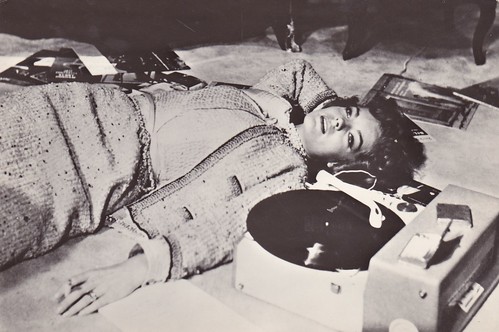
Czech postcard by Pressfoto, Praha (Prague). Photo: publicity still for in the episode Il lavoro/The Job by Luchino Visconti, part of the episodefilm Boccaccio '70 (1962). Collection: Carla Bosch.
The first card with Romy Schneider is the story Il lavoro about a woman who finds out that her husband visits prostitutes. The pair is financially dependent on her father who stops his financial support after he gets wind of his son-in-law’s escapades. Romy decides to take matters in her own hand and to become an independent woman by earning her own money. She will neither be dependent on her father or her husband!
The card shows Romy lying on the floor next to a record player with a cigarette in her hand. Perhaps she ponders on how to make her husband pay for his infidelity, how to win him back, and how to be a strong financially independent woman at the same time. I don’t know whether the end is satisfactory in that respect, because she humiliates her husband and makes him cringe like a worm and she makes it clear to him she is more sensual and sexually attractive than the callgirls he pays. So far for being an independent working girl, she did save her marriage.

Czech postcard by Pressfoto, Praha (Prague). Photo: publicity still for Boccaccio '70 (Vittorio De Sica a.o., 1962) with Sophia Loren. Collection: Carla Bosch.
The second card with Sophia Loren is the story La riffa about a lottery. Sophia works in a fairground attraction and is the grand prize in a lottery. The man who has the winning lottery ticket is allowed to spend the night with Sophia. A great deal of the film is about the efforts of the horny visitors to the fairground to obtain the winning ticket. Sophia, however, falls in love with a handsome young visitor to the carnival. When a nerdy, shy man is the winner of the night with Sophia, they pretend to spend the night together and let everybody think they did it. The nerdy man is considered a hero, and Sophia escapes with the man she fell in love with. Hmm…
About the card: we see Sophia on a bed with a man in front of her. We only see the man’s back; he is balding. Sophia looks at something else than the man and has her mouth open. Perhaps this is the scene in which Sophia and the winner spend the night and have to pretend: Sophia screams and they both make the bed move.… I do not have the faintest idea. It is a very nice card with Sophia Loren, however.
Two cards are of the movie Gepard, Czech for Il Gattopardo/The Leopard, an Italian movie with Alain Delon, Claudia Cardinalova, and Burt Lancaster released in 1963. Burt Lancaster plays the role of Prince of Salina, Alain Delon his nephew, and Claudia Cardinale is the mayor’s daughter. The movie is about a rapidly changing society and a fading past. Lancaster plays an aristocratic elegant nobleman enjoying the wealth and privileges that are inherent to his title and name, symbolising the ‘old world’. The mayor on the other hand has become rich by land speculation, representing the nouveau riche, ‘the new world’.
Alain Delon, heir to the old world, falls for Claudia Cardinale, heiress to the new world. Burt reluctantly agrees to a marriage between Alain and Claudia. The film ends with a spectacular ball, a scene that lasts for 45 minutes. Burt realises he is becoming a relic from the past. Had he been born two decades later, he might have married Claudia himself.
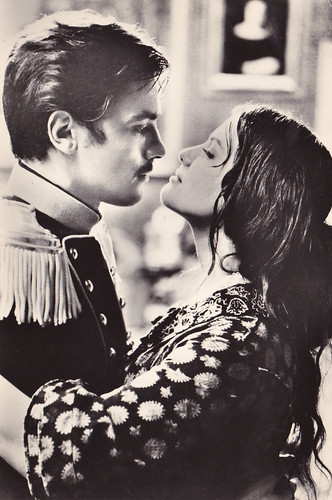
Czech postcard by Pressfoto, Praha (Prague). Photo: publicity still for Il Gattopardo/The Leopard (Luchino Visconti, 1963) with Alain Delon and Claudia Cardinale. Collection: Carla Bosch.
On this card we see Alain Delon and Claudia Cardinale, the couple that will start a new ‘mixed’ society of old money and nouveau riche.

Czech postcard by Pressfoto, Praha (Prague). Photo: publicity still for Il Gattopardo/The Leopard (Luchino Visconti, 1963) with Alain Delon, Claudia Cardinale and Burt Lancaster. Collection: Carla Bosch.
I guess this picture is of the ball scene. We see the young couple looking at old Burt. Alain is looking serious, Claudia is hanging on his shoulder and looks coyly at Burt. With the old and new world in mind, the picture conveys quite a different meaning.
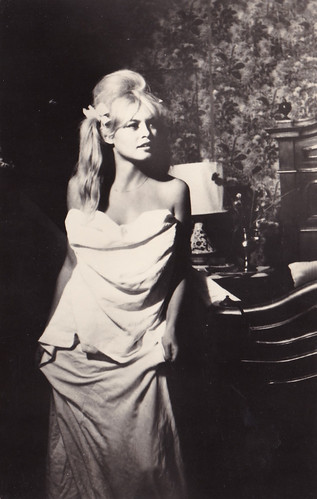
Czech postcard by Pressfoto, Praha (Prague). Photo: publicity still for Vie privée/A Very Private Affair (Louis Malle, 1962). Collection: Carla Bosch.
And now Brigitte Bardotova in Soukromy Zivot or Vie Privée, released in 1962. Brigitte Bardot plays a girl who lives in Switzerland with her widowed mother. She is infatuated with Marcello Mastroianni who is married to a friend of hers, unfortunately. There is some unclarity on the different sites that discuss this movie. Some say Marcello is married to her friend, others say he is her mother’s ex-lover. Perhaps he is both. Anyway, Brigitte has had it in Switzerland and moves to Paris where she becomes a famous movie star and model. She experiences the negative aspects of such a career: she does not have a private life and is regarded as public property.
She returns to Switzerland where she finds Marcello divorced, fortunately. They start an affair, but the fans and paparazzi claim her again. She trusts Marcello to protect her from the intrusive press that hounds her. But Marcello, a film director himself, seems more interested in a play he is directing. Brigitte becomes depressed and withdraws from public life. It could have been the story of Brigitte Bardot herself, the actress and model! Brigitte was 28 when she played the leading role in A Very Private Affair, but she apparently had great foresight. The film was not a great success. Yet, rather interesting as we look at it through new eyes perhaps? I don’t know what to make of the postcard. We see Brigitte wrapped in a bed sheet. The bed is behind her. She looks lovely in that sheet.
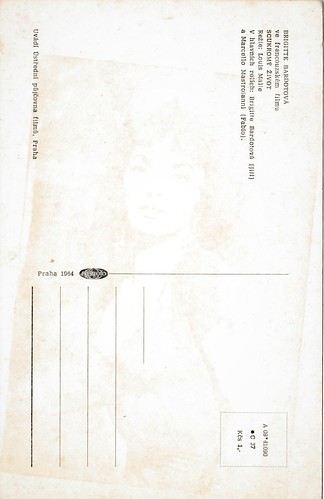
The postcard’s back is interesting too: if you look closely, you can see an image of….Gina Lollobrigida!
The cards were probably stored close together, nearly glued together so that Gina left an imprint on Brigitte’s back. Unfortunately the card with Lollobrigida was not in the package I bought.
There are three cards of the movie Nekdo To Rad Horke, or Some Like It Hot, released in 1959.

Czech postcard by Pressfoto, Praha (Prague). Photo: publicity still for Some Like it Hot (Billy Wilder, 1959) with Jack Lemmon and Tony Curtis. Collection: Carla Bosch.
The first card is with Jack Lemmon and Tony Curtis, two musicians who are on the run after they have witnessed a murder. They dress up as women and join a female jazz-band. In this picture they are playing a bass (Jack Lemmon), and a saxophone (Tony Curtis). Tony is in love with Marilyn, but cannot tell her he is a man, so instead he tries to become best friends with her.

Czech postcard by Pressfoto, Praha (Prague). Photo: publicity still for Some Like it Hot (Billy Wilder, 1959). Collection: Carla Bosch.
The second card is with Jack Lemmon and Joe E. Brown. Joe is a millionaire and in love with Jack Lemmon. Jack cannot tell either he is a man, so he goes through with it, but eventually has to confess to Joe he is a man when Joe asks to marry him. Joe is in love and won’t be deterred: “Well, nobody’s perfect”.
The topics of homosexuality and men wearing drag costumes and make-up were taboo in those days. But times have changed. It is considered to be one of the best films and comedies of all times.
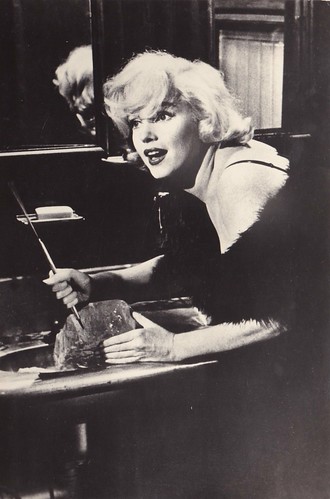
Czech postcard by Pressfoto, Praha (Prague). Photo: publicity still for Some Like it Hot (Billy Wilder, 1959) with Marilyn Monroe. Collection: Carla Bosch.
The third card is with Marilyn cutting up something. Honestly, I saw the movie twice, but I cannot for the life of me remember what Marilyn is cutting. I have to watch it a third time. (It's ice, ed.)
Then there is one card of the film Mustangove, or The Misfits. Released in 1961, with, of course Marilyn Monroeova.
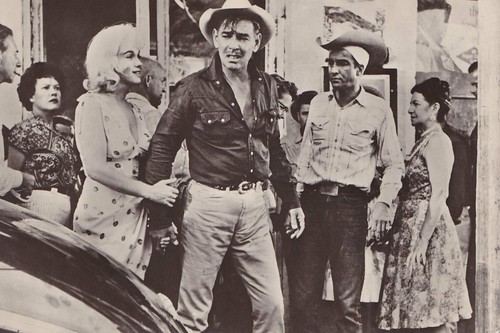
Czech postcard by Pressfoto, Praha (Prague). Photo: publicity still for The Misfits (John Huston, 1961). Collection: Carla Bosch.
In the picture we see Marilyn Monroe, Clark Gable and Montgomery Clift. For Marilyn Monroe and Clark Gable The Misfits would be the last completed movie they made.
Marilyn had a troubled childhood and spent most of it in foster homes and an orphanage. As a child, she often claimed that Clark Gable was her father. Her marriage to Arthur Miller, writer of The Misfits was ending when the film was shot. She was addicted to drugs and alcohol and even had to be hospitalised for two weeks to detox.
Twelve days after the film was completed, Gable died of a heart attack. His widow was pregnant at the time and gave birth to a son after his death. It was rumoured she blamed Marilyn for Clark’s death, because of all the stress Marilyn’s behaviour brought, but I doubt this is true as Marilyn was present at the baby’s christening four months later. Perhaps she meant he was fed up with the whole crew, not just Marilyn…
Montgomery Clift was in a car accident five years earlier. He had extensive plastic surgery on the left side of his face. After that he only wanted the right side of his face to be photographed. Then this must be a rare picture of his left side that was immobile after the crash and many operations. (His film career after the crash was referred to as “The longest suicide in Hollywood history”.)
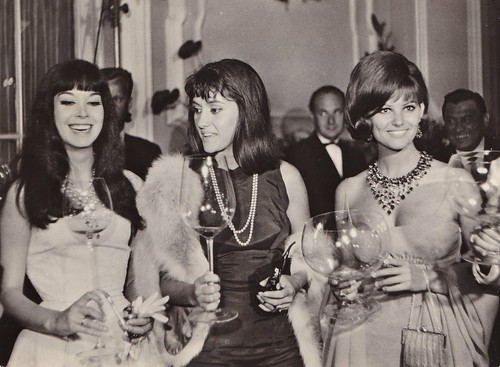
Czech postcard by Pressfoto, Praha (Prague). Collection: Carla Bosch.
The last card is titled 'Mezinarodni Filmovy Festival V Karlovych Varrech', or 'The Karlovy Vary International Film Festival'. This is a Czech film festival held every year in Karlovy Vary. I am ashamed to say I have never heard of it. It apparently is one of the oldest film festivals in the world and a major event in Central and Eastern Europe.
And I am even more ashamed when I see the actresses: Elisa Montes, Piqueras A. Herrera, and Claudia Cardinale. The festival welcomed some famous names. I wonder why their names are without a Czech twist this time. They are all three lovely actresses. No doubt about that. But those glasses they are holding: they are huge! I don’t know whether they are average glasses in the Czech Republic. The glasses held by Montes and Herrera are glasses for white wine, the one in Cardinale’s hand is for red wine, and there is someone on the right, outside the picture, who is also holding a red wine glass. If I have to guess, each glass can contain a full bottle of wine. No wonder they are all laughing.
All the cards were printed in 1964. I have the impression they are part of one series, but I have no idea whether they were printed for a certain occasion (perhaps the Karlovy Vary film festival) or they were just printed at the same time by accident. I do have the idea there must be more cards that belong to this series.
The cards with Marilyn Monroe must have been the reason why I bought them. I may not have thought so at the time, but I now realise they are really beautiful cards. All of them.
It might be worth another expedition to the Dachboden."
Please, do another expedition, Carla. Thank you very much for sharing this Dachbodenfund with us!
If a Thousand Clarinets
Carla: "There are four cards of the movie Kdyby tisic klarinetu. “If a Thousand Clarinets” (English title) is a Czechoslovak movie released in 1965. It is a fantasy musical film about a mysterious statue of the composer Johann Sebastian Bach that changes guns into musical instruments. The news spreads and a television station decides to make a documentary film about the subject. My guess is that it must be something like how music can change people. And, more particular, how soldiers change when they are not holding guns, but music instruments instead... But that is just a wild guess.

Czech postcard by Pressfoto, Praha (Prague). Photo: publicity still for Kdyby tisic klarinetu/If a Thousand Clarinets (Ján Rohác, Vladimír Svitácek, 1965) with at left Karel Gott and Jana Brejchova in white. Collection: Carla Bosch.

Czech postcard by Pressfoto, Praha (Prague). Photo: publicity still for Kdyby tisic klarinetu/If a Thousand Clarinets (Ján Rohác, Vladimír Svitácek, 1965). Collection: Carla Bosch.
I suspect that on these two cards are the film crew making the documentary. With Jana Brejchova, Waldemar Matuska, Hana Hegerova, Eva Pilarova, Karel Gott, Jiri Suchy, and Jiri Slitr. They are all watching a television. In the public are soldiers who are holding music instruments.

Czech postcard by Pressfoto, Praha (Prague). Photo: publicity still for Kdyby tisic klarinetu/If a Thousand Clarinets (Ján Rohác, Vladimír Svitácek, 1965) with Pavlina Filipovska. Collection: Carla Bosch.
Czech actress Pavlina Filipovska plays the role of landlady of a pension. In this picture she sits on a piano and four 'soldiers' are playing the saxophone.

Czech postcard by Pressfoto, Praha (Prague). Photo: publicity still for Kdyby tisic klarinetu/If a Thousand Clarinets (Ján Rohác, Vladimír Svitácek, 1965) with Jiri Suchy and Jiri Slitr. Collection: Carla Bosch.
The fourth card is with Jiri Suchy and Jiri Slitr, both Czech actors. I read that Jiri Suchy was responsible for the story and Jiri Slitr composed the music. They also play a role in the movie; they are both paratroopers. In this picture they have cast off their military uniform and wear civilian clothes with cool hats.
I don’t know the Czech language. When I used Google Translate, I doubted Google’s translation skills. And as there was not much published about this movie in English, I had to make guesses. I did understand, however, that the film received some enthusiastic reviews. Although the subject, provide soldiers with music instruments and take away their guns, seems rather corny, it apparently touched a (musical?) string.

Czech postcard by Pressfoto, Praha (Prague). Photo: publicity still for Egy ember, aki nincs/Key to the Murder (Viktor Gertler, 1964). Collection: Carla Bosch.
There is one card of the movie Klic k Vrazde. In English Key to the Murder. Immediately my imagination ran wild in connection with this card: a murderer with a dead woman in his arms…. On the run and thinking where to hide the body. I tried to look up this movie on the internet, but I found there was not much to look up.
It is a Hungarian movie with Miklos Gabor and Eva Vass, who are both on the card, in the leading roles. Miklos Gabor was married to Éva Ruttkai and later to Eva Vass. I cannot find the marriage dates, because that might have provided a juicy gossip. So I think it is safe to conclude that Miklos murdered Eva and is looking around with an uncertain look on his face where to hide her. Maybe he did not kill her on purpose. Perhaps there are Czech readers or experts of Czech cinema who can comment on or clarify this mysterious picture?
The difficult postcards
I started to describe the 'difficult' postcards. It took a lot of time to find nothing. I think I must have bought these cards because of the more famous movie stars:

Czech postcard by Pressfoto, Praha (Prague). Photo: Dany Carrel, Gérard Philipe and Danielle Darrieux in the Émile Zola adaptation Pot Bouille/Lovers of Paris (Julien Duvivier, 1957) Collection: Carla Bosch.
For example Dany Carrelova, Gérard Philipe and Danielle Darrieuxova in the movie Pod Poklickou. I cannot help mentioning those names in Czech, because they look and sound rather funny. They have been given a Czech twist.
The movie’s original name is French: Pot-Bouille. It was released in 1957, based on Emile Zola’s novel of the same name. The English title is “Lovers of Paris”. Dany Carrel is in love with Gérard Philipe, but Gerard only has eyes for Danielle Darrieux who is too haughty to notice him. In the end Dany is married to someone else, but is Gerard’s mistress. Danielle is widowed and suddenly sees Gerard as a man who has possibilities. I know this summary is simplistic and does not do the movie justice, but perhaps we now understand the look on the faces in the picture.
The next two cards are with world-famous film stars: Romy Schneiderova and Sophia Lorenova. They are two of the leading stars in Boccaccio, the original title being Boccaccio ’70. There are two other leading ladies in this movie: Anita Ekberg(ova) and Marisa Solinas(ova), but I don’t have a card of them, at least, not a Czech one that belongs to this series.
Boccaccio '70 is a collection of four different movies directed by four different directors. Each story describes a different aspect of love and morality. Giovanni Boccaccio did something similar in his 'Decameron' but that was in the 14th century and is a frame story consisting of 100 tales.
Boccaccio ‘70 was released in 1962 (and has 4 tales).

Czech postcard by Pressfoto, Praha (Prague). Photo: publicity still for in the episode Il lavoro/The Job by Luchino Visconti, part of the episodefilm Boccaccio '70 (1962). Collection: Carla Bosch.
The first card with Romy Schneider is the story Il lavoro about a woman who finds out that her husband visits prostitutes. The pair is financially dependent on her father who stops his financial support after he gets wind of his son-in-law’s escapades. Romy decides to take matters in her own hand and to become an independent woman by earning her own money. She will neither be dependent on her father or her husband!
The card shows Romy lying on the floor next to a record player with a cigarette in her hand. Perhaps she ponders on how to make her husband pay for his infidelity, how to win him back, and how to be a strong financially independent woman at the same time. I don’t know whether the end is satisfactory in that respect, because she humiliates her husband and makes him cringe like a worm and she makes it clear to him she is more sensual and sexually attractive than the callgirls he pays. So far for being an independent working girl, she did save her marriage.

Czech postcard by Pressfoto, Praha (Prague). Photo: publicity still for Boccaccio '70 (Vittorio De Sica a.o., 1962) with Sophia Loren. Collection: Carla Bosch.
The second card with Sophia Loren is the story La riffa about a lottery. Sophia works in a fairground attraction and is the grand prize in a lottery. The man who has the winning lottery ticket is allowed to spend the night with Sophia. A great deal of the film is about the efforts of the horny visitors to the fairground to obtain the winning ticket. Sophia, however, falls in love with a handsome young visitor to the carnival. When a nerdy, shy man is the winner of the night with Sophia, they pretend to spend the night together and let everybody think they did it. The nerdy man is considered a hero, and Sophia escapes with the man she fell in love with. Hmm…
About the card: we see Sophia on a bed with a man in front of her. We only see the man’s back; he is balding. Sophia looks at something else than the man and has her mouth open. Perhaps this is the scene in which Sophia and the winner spend the night and have to pretend: Sophia screams and they both make the bed move.… I do not have the faintest idea. It is a very nice card with Sophia Loren, however.
A new ‘mixed’ society of old money and nouveau riche
Two cards are of the movie Gepard, Czech for Il Gattopardo/The Leopard, an Italian movie with Alain Delon, Claudia Cardinalova, and Burt Lancaster released in 1963. Burt Lancaster plays the role of Prince of Salina, Alain Delon his nephew, and Claudia Cardinale is the mayor’s daughter. The movie is about a rapidly changing society and a fading past. Lancaster plays an aristocratic elegant nobleman enjoying the wealth and privileges that are inherent to his title and name, symbolising the ‘old world’. The mayor on the other hand has become rich by land speculation, representing the nouveau riche, ‘the new world’.
Alain Delon, heir to the old world, falls for Claudia Cardinale, heiress to the new world. Burt reluctantly agrees to a marriage between Alain and Claudia. The film ends with a spectacular ball, a scene that lasts for 45 minutes. Burt realises he is becoming a relic from the past. Had he been born two decades later, he might have married Claudia himself.

Czech postcard by Pressfoto, Praha (Prague). Photo: publicity still for Il Gattopardo/The Leopard (Luchino Visconti, 1963) with Alain Delon and Claudia Cardinale. Collection: Carla Bosch.
On this card we see Alain Delon and Claudia Cardinale, the couple that will start a new ‘mixed’ society of old money and nouveau riche.

Czech postcard by Pressfoto, Praha (Prague). Photo: publicity still for Il Gattopardo/The Leopard (Luchino Visconti, 1963) with Alain Delon, Claudia Cardinale and Burt Lancaster. Collection: Carla Bosch.
I guess this picture is of the ball scene. We see the young couple looking at old Burt. Alain is looking serious, Claudia is hanging on his shoulder and looks coyly at Burt. With the old and new world in mind, the picture conveys quite a different meaning.
Brigitte Bardotova

Czech postcard by Pressfoto, Praha (Prague). Photo: publicity still for Vie privée/A Very Private Affair (Louis Malle, 1962). Collection: Carla Bosch.
And now Brigitte Bardotova in Soukromy Zivot or Vie Privée, released in 1962. Brigitte Bardot plays a girl who lives in Switzerland with her widowed mother. She is infatuated with Marcello Mastroianni who is married to a friend of hers, unfortunately. There is some unclarity on the different sites that discuss this movie. Some say Marcello is married to her friend, others say he is her mother’s ex-lover. Perhaps he is both. Anyway, Brigitte has had it in Switzerland and moves to Paris where she becomes a famous movie star and model. She experiences the negative aspects of such a career: she does not have a private life and is regarded as public property.
She returns to Switzerland where she finds Marcello divorced, fortunately. They start an affair, but the fans and paparazzi claim her again. She trusts Marcello to protect her from the intrusive press that hounds her. But Marcello, a film director himself, seems more interested in a play he is directing. Brigitte becomes depressed and withdraws from public life. It could have been the story of Brigitte Bardot herself, the actress and model! Brigitte was 28 when she played the leading role in A Very Private Affair, but she apparently had great foresight. The film was not a great success. Yet, rather interesting as we look at it through new eyes perhaps? I don’t know what to make of the postcard. We see Brigitte wrapped in a bed sheet. The bed is behind her. She looks lovely in that sheet.

The postcard’s back is interesting too: if you look closely, you can see an image of….Gina Lollobrigida!
The cards were probably stored close together, nearly glued together so that Gina left an imprint on Brigitte’s back. Unfortunately the card with Lollobrigida was not in the package I bought.
Well, nobody’s perfect
There are three cards of the movie Nekdo To Rad Horke, or Some Like It Hot, released in 1959.

Czech postcard by Pressfoto, Praha (Prague). Photo: publicity still for Some Like it Hot (Billy Wilder, 1959) with Jack Lemmon and Tony Curtis. Collection: Carla Bosch.
The first card is with Jack Lemmon and Tony Curtis, two musicians who are on the run after they have witnessed a murder. They dress up as women and join a female jazz-band. In this picture they are playing a bass (Jack Lemmon), and a saxophone (Tony Curtis). Tony is in love with Marilyn, but cannot tell her he is a man, so instead he tries to become best friends with her.

Czech postcard by Pressfoto, Praha (Prague). Photo: publicity still for Some Like it Hot (Billy Wilder, 1959). Collection: Carla Bosch.
The second card is with Jack Lemmon and Joe E. Brown. Joe is a millionaire and in love with Jack Lemmon. Jack cannot tell either he is a man, so he goes through with it, but eventually has to confess to Joe he is a man when Joe asks to marry him. Joe is in love and won’t be deterred: “Well, nobody’s perfect”.
The topics of homosexuality and men wearing drag costumes and make-up were taboo in those days. But times have changed. It is considered to be one of the best films and comedies of all times.

Czech postcard by Pressfoto, Praha (Prague). Photo: publicity still for Some Like it Hot (Billy Wilder, 1959) with Marilyn Monroe. Collection: Carla Bosch.
The third card is with Marilyn cutting up something. Honestly, I saw the movie twice, but I cannot for the life of me remember what Marilyn is cutting. I have to watch it a third time. (It's ice, ed.)
Then there is one card of the film Mustangove, or The Misfits. Released in 1961, with, of course Marilyn Monroeova.

Czech postcard by Pressfoto, Praha (Prague). Photo: publicity still for The Misfits (John Huston, 1961). Collection: Carla Bosch.
In the picture we see Marilyn Monroe, Clark Gable and Montgomery Clift. For Marilyn Monroe and Clark Gable The Misfits would be the last completed movie they made.
Marilyn had a troubled childhood and spent most of it in foster homes and an orphanage. As a child, she often claimed that Clark Gable was her father. Her marriage to Arthur Miller, writer of The Misfits was ending when the film was shot. She was addicted to drugs and alcohol and even had to be hospitalised for two weeks to detox.
Twelve days after the film was completed, Gable died of a heart attack. His widow was pregnant at the time and gave birth to a son after his death. It was rumoured she blamed Marilyn for Clark’s death, because of all the stress Marilyn’s behaviour brought, but I doubt this is true as Marilyn was present at the baby’s christening four months later. Perhaps she meant he was fed up with the whole crew, not just Marilyn…
Montgomery Clift was in a car accident five years earlier. He had extensive plastic surgery on the left side of his face. After that he only wanted the right side of his face to be photographed. Then this must be a rare picture of his left side that was immobile after the crash and many operations. (His film career after the crash was referred to as “The longest suicide in Hollywood history”.)
But those glasses they are holding...

Czech postcard by Pressfoto, Praha (Prague). Collection: Carla Bosch.
The last card is titled 'Mezinarodni Filmovy Festival V Karlovych Varrech', or 'The Karlovy Vary International Film Festival'. This is a Czech film festival held every year in Karlovy Vary. I am ashamed to say I have never heard of it. It apparently is one of the oldest film festivals in the world and a major event in Central and Eastern Europe.
And I am even more ashamed when I see the actresses: Elisa Montes, Piqueras A. Herrera, and Claudia Cardinale. The festival welcomed some famous names. I wonder why their names are without a Czech twist this time. They are all three lovely actresses. No doubt about that. But those glasses they are holding: they are huge! I don’t know whether they are average glasses in the Czech Republic. The glasses held by Montes and Herrera are glasses for white wine, the one in Cardinale’s hand is for red wine, and there is someone on the right, outside the picture, who is also holding a red wine glass. If I have to guess, each glass can contain a full bottle of wine. No wonder they are all laughing.
All the cards were printed in 1964. I have the impression they are part of one series, but I have no idea whether they were printed for a certain occasion (perhaps the Karlovy Vary film festival) or they were just printed at the same time by accident. I do have the idea there must be more cards that belong to this series.
The cards with Marilyn Monroe must have been the reason why I bought them. I may not have thought so at the time, but I now realise they are really beautiful cards. All of them.
It might be worth another expedition to the Dachboden."
Please, do another expedition, Carla. Thank you very much for sharing this Dachbodenfund with us!
1 comment:
I loved your text, Carla. Keep it up!
Post a Comment